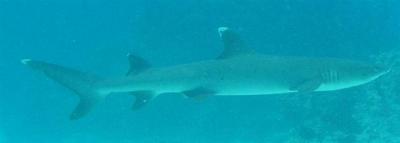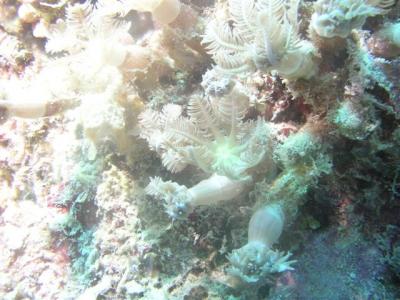The Great Barrier Reef is made up of about 2900 separate reefs. Some are barrier reefs, which run along the Australian continental shelf and separate the ocean from the mainland, and the rest are fringing reefs, located within the lagoon created by the barrier reefs. It is one of the seven wonders of the natural world. It stretches for 2000 kilometers from the tropic of Capricorn to just south of Papua New Guinea and is the most extensive reef system in the world. Within the Barrier Reef are 1500 species of fish, 400 types of coral, 4,000 breeds of mollusks, 800 Echinoderms species (including sea cucumbers), 500 varieties of seaweed, 200 bird species, 1500 sponge species, 30 plus marine mammal species and 118 species of butterflies. The diving within the reef is supposed to be extraordinary with so many colorful things to see in the water.
Being as avid of a diver as Jaime is, he wasted no time in organizing a dive trip for us. We had been told that day diving trips out of Cairns aren’t that good. With the huge volume of tourists here, all of the sites within a day’s drive radius of Cairns are completely over-dived and suffer from damage from too much human contact. We were advised to go on an overnight or longer trip where they take you further out, or to take a trip out of the city of Port Douglas, located an hour north (by car) of Cairns. Being as we just got off a long passage, we decided that another overnight boat trip just didn’t sound good. We opted for a day trip out of Port Douglas.
A van picked us up at 06:50 to take us to our dive boat. The drive up is very pretty. Just outside of Cairns there is a lot of farmland and fields with gently rolling hills. As you go farther north, there are more and more trees and some sections are almost forest like. The road paralleled the coast a lot of the way, and it was especially pretty seeing the ocean and the forest at once. There are lots and lots of newer looking tract home developments, most of them similar to what we see at home.
We arrived at the marina in Port Douglas, which had a boardwalk with a bunch of shops and restaurants that border the edge of the marina. We checked in at one of these little shops, and then were herded over to the boat. The boat was enormous, looking almost like a ferry boat. The line of people getting onto the boat was huge. They were just packing the people in. We were a bit nervous about the diving situation with so many people.
We were greeted with tea, coffee and muffins. We were divided into groups. There were three dive groups, a snorkeling group, and a glass bottom boat group. Each group was briefed separately about the day’s agenda. Jaime was a bit horrified by the briefing, which was essentially “Just follow your guide”. It was a bit of a zoo with so many people and so many guides and so many activities happening at once.
Our first stop was called Whaler. We were diving from the boat against the current, then drifting back to the boat with the current. We spent the first 20 minutes of the dive fighting a strong current, looking mostly at sand, with just little bits of uninteresting coral formations along the way. The guide was swimming really fast, so we didn’t get a chance to stop and look at the fish along the way. There weren’t many fish at all, which surprised us. By the time we finally got to the coral, we were close to being out of air. The current was pushing us along at a good clip, so it was still hard to stop and get a good look at the fish. The coral area turned out to be incredibly shallow, and we were so close to the surface that we may as well have been snorkeling. The coral was OK, but not the beautiful stuff the Great Barrier Reef is legendary for. We were all upset when we got out of the water. Christi and Eric think that being as the reef was so shallow, it would have been a much more fun snorkel than dive. We were frustrated that we spent so much time in sand and so little in the coral.
A half hour later, we did the second dive at the same spot, but this time it was much better. We did a drift dive down current along a coral wall, and when we were done the glass bottom boat picked us up. The coral was nice, but not spectacular. We saw a pregnant white tip reef shark and a few smaller ones. One of the smaller ones is pictured below. We saw a giant barracuda. We saw a lizard fish, which looks kind of like a lizard, and a blenny, which is nay blue and yellow. Both are pictured below. We saw butterfly fish and damsels, which we have seen just about every place we have dived in the South Pacific. There is a picture of a butterfly fish below swimming past some coral. Check out the design these type of coral polyps make on the surface. Also pictured below is a new type of coral we have never seen before. They open and close as they feed. The guide slowed down for this dive, so we were able to look more closely at the surroundings and enjoy the dive more.



Sharing your adventure and your perspective of the cruising you are doing is such an incredible gift to those of us that are not on our boats. I
applaud you for taking the leap and making the decision to explore. As you know, the rest of us lemmings are too trained or too afraid to leave. I am always excited to read your log as it brightens the day here in Wash DC.
Thanks for spending the hours you do to write your log.
Sincerely
David Duncan
Looks amazing!